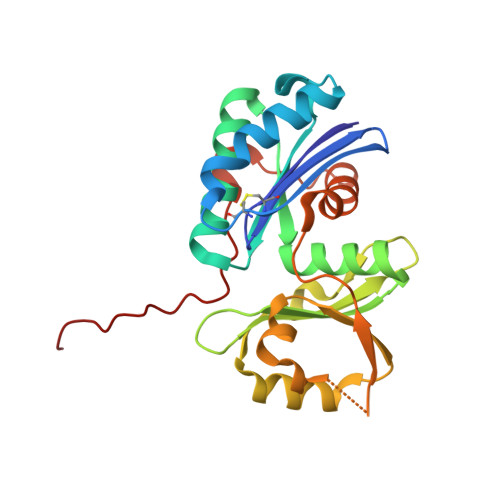Crystal Structure of the Dimer of Two Essential Salmonella Typhimurium Proteins, Ygjd & Yeaz and Calorimetric Evidence for the Formation of a Ternary Ygjd-Yeaz-Yjee Complex.
Nichols, C.E., Lamb, H.K., Thompson, P., Omari, K.E., Lockyer, M., Charles, I., Hawkins, A.R., Stammers, D.K.(2013) Protein Sci 22: 628
- PubMed: 23471679
- DOI: https://doi.org/10.1002/pro.2247
- Primary Citation of Related Structures:
3ZET, 3ZEU - PubMed Abstract:
YgjD from COG0533 is amongst a small group of highly conserved proteins present in all three domains of life. Various roles and biochemical functions (including sialoprotease and endonuclease activities) have been ascribed to YgjD and orthologs, the most recent, however, is involvement in the post transcriptional modification of certain tRNAs by formation of N6-threonyl-adenosine (t⁶A) at position 37. In bacteria, YgjD is essential and along with YeaZ, YjeE, and YrdC has been shown to be 'necessary and sufficient' for the tRNA modification. To further define interactions and possible roles for some of this set of proteins we have undertaken structural and biochemical studies. We show that formation of the previously reported heterodimer of YgjD-YeaZ involves ordering of the C-terminal region of YeaZ which extends along the surface of YgjD in the crystal structure. ATPγS or AMP is observed in YgjD while no nucleotide is bound on YeaZ. ITC experiments reveal previously unreported binary and ternary complexes which can be nucleotide dependent. The stoichiometry of the YeaZ-YgjD complex is 1:1 with a K(D) of 0.3 µM. YgjD and YjeE interact only in the presence of ATP, while YjeE binds to YgjD-YeaZ in the presence of ATP or ADP with a K(D) of 6 µM. YgjD doesn't bind the precursors of t⁶A, threonine, and bicarbonate. These results show a more complex set of interactions than previously thought, which may have a regulatory role. The understanding gained should help in deriving inhibitors of these essential proteins that might have potential as antibacterial drugs.
Organizational Affiliation:
Division of Structural Biology, The Wellcome Trust Centre for Human Genetics, University of Oxford, Roosevelt Drive, Oxford, United Kingdom.


















